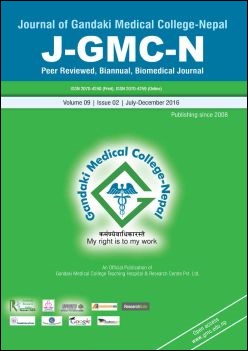Effect of Yoga Breathing Exercises on Ventilatory Function
DOI:
https://doi.org/10.3126/jgmcn.v9i2.17861Keywords:
Yoga, Breathing exercise, Ventilatory functionAbstract
Introduction: Controlled breathing not only keeps your mind and body functioning at their best, it can also lower blood pressure, promote feelings of calm and relaxation and help you de-stress. Many experts encourage using the yoga breathing exercises as a means of increasing awareness, mindfulness and reducing anxiety. Over-worked, under-slept, and feeling pressure may impair breathing pattern. There are some yoga breathing exercise techniques that improve ventilator function.
Objective: To assess the effect of yoga breathing exercises on their ventilatory function. Methods: Forty eight male and female students of 18 - 30 years were involved in the study of ventilatory function before and after yoga breathing exercise. Pulmonary function tests were performed with the subject sitting in a comfortable chair. Initial recording of tidal volume, inspiratory capacity, inspiratory reserve volume, expiratory reserve volume, forced vital capacity, and timed vital capacity in one second were measured.
Results: There was significant increase in inspiratory reserve volume, expiratory reserve volume, vital capacity, forced expiratory volume in one second and forced vital capacity after yoga breathing exercise.
Conclusion: Yoga breathing exercise improves ventilatory function.
Journal of Gandaki Medical College
Volume, 09, Number 2, July December 2016, page: 17-22
Downloads
Downloads
Published
How to Cite
Issue
Section
License
This license allows reusers to distribute, remix, adapt, and build upon the material in any medium or format for noncommercial purposes only, and only so long as attribution is given to the creator.




